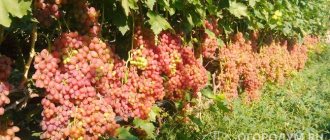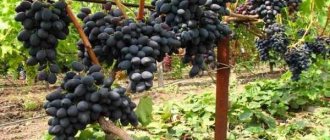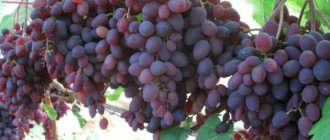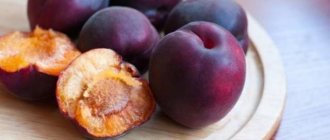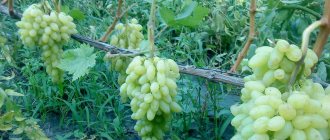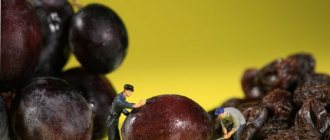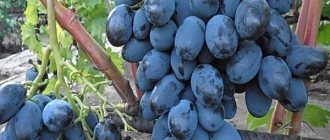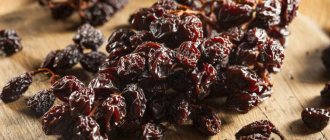Fruits and berries » Grapes
0
993
Article rating
Kira Stoletova
Table raisin Black Potapenko is considered one of the best varieties on the market. It was obtained by crossing 2 dessert varieties. There is a large amount of sugar in its taste. It is better to consume it fresh than to process the fruits to make drinks.
Grapes raisins Black Potapenko
Description and characteristics of the variety
Kishmish Potapenko grapes are grown in different climatic zones. The vine tolerates frosts of 20 degrees and heat of 40 degrees Celsius. Fruit ripening begins in early August, and the last bunches are harvested by winegrowers in late autumn. The sugar content in ripened berries sometimes reaches 30%. The absence of seeds and sweet taste determine the directions for use of the variety:
- For the production of raisins.
- In winemaking.
- As a fresh, healthy dessert.
The vine grows up to 5 meters in height. The inflorescences are self-pollinating. The grape clusters are large, conical in shape. The round fruits are dark blue or black in color and covered with a waxy coating. The average weight of the berries is 2 grams.
Composition of sultanas
Black Kishmish berries contain:
- 17.4% carbohydrates;
- 0.7% protein;
- 0.7% fat.
Grapes are rich in minerals and vitamins; they contain:
- calcium, potassium and iron;
- vitamin C, A, group B, E and K.
The calorie content of seedless grapes ranges from 65 to 75 kcal per 100 g of fresh berries. The juice of sweet berries has a low acidity of 4-5 g/l.
Advantages and disadvantages of Kishmish black Potapenko grapes
Advantages and disadvantages
Ability to withstand negative air temperatures
Resistant to most fungal diseases
Thanks to the dense skin of the berries, they are stored for a long time and do not lose their marketable shape.
Roots in different types of soil
High yield (up to 250 centners per hectare)
Violation of irrigation rules leads to the death of grapes
Despite frost resistance, it requires insulation in winter
Black Kishmish Potapenko grapes are considered by gardeners to be one of the best varieties.
Benefits and contraindications
Like any grape, “Kishmish black Potapenko” is a strong antioxidant, contains a complex of vitamins A, C, E and group B, and is rich in trace elements of calcium, iron, phosphorus, iodine and magnesium. Thanks to this, grapes have a beneficial effect on the body’s immune system, improve metabolism, and have an anti-edematous effect. In cosmetology it is used as a product that has an antioxidant effect, slowing down aging.
Recommended for people with increased nervous excitability and stressful conditions. For small children it is a natural substitute for sweets and sweets.
Contraindicated for people suffering from diabetes and heart failure. It is also worth minimizing the consumption of sweet varieties of “Kishmish” if you are on a diet or prone to obesity.
How to grow fruit crops
In order for the plant to take root on the site, certain rules must be followed.
Boarding time
The fruit crop needs sunlight. The seedlings are transferred to the ground with the onset of warm weather. The earth must warm up completely so that the root system does not freeze and receives the necessary nutrients for further development. Therefore, it is recommended to start planting grapes in mid-spring.
See also
Description of Bianca grapes, characteristics of the variety and features of cultivation and careRead
Usually in April the weather becomes more stable. This is important for young shoots that are sensitive to climate fluctuations. Only mature grapes can withstand temperature changes. Seedlings gain enough strength to withstand atmospheric changes 3 years after planting.
Place and soil
The southern side of the plot is suitable for growing grapes. Choose a sunny spot near a hedge or install trellises to support the vines.
Expert opinion
Zarechny Maxim Valerievich
Agronomist with 12 years of experience. Our best country expert.
Ask a Question
The plant takes root in different soils. Loamy soils and sandstones are suitable. Seedlings also develop normally in black soil conditions.
Sometimes it is necessary to improve the soil composition:
- Too dense soil is diluted with sand.
- Liming is carried out at high (more than 4%) acidity. For each square meter of vineyard, apply 5 liters of solution.
When growing grapes, standard fertilizing with mineral fertilizers is useful.
Landing
Only strong and healthy shoots are planted in the ground. Select grafted seedlings without signs of disease or damaged areas.
The hole is prepared 2 months before placing planting material:
- Dig a hole 80 centimeters deep. The width is usually made the same size.
- Fill the drainage layer.
- The soil is enriched with peat, humus or other organic matter.
Preliminary preparation is required so that the soil absorbs the elements necessary for the growth of grapes. When placed in a hole, the roots of the seedling are evenly distributed in the internal space and covered with a layer of soil. The shoot is watered with warm water. One bush requires up to 20 liters of liquid.
Application of sultana berries
Kishmish berries are very tasty fresh. After special drying, you can obtain raisins, which are subsequently used for baking and preparing other culinary dishes. Kishmish is used to make candies, jam, and added to drinks.
Several methods are used for drying in the garden. One of the oldest methods of “aftobi” was used specifically for Black Kishmish in its natural habitat, where the berries had time to dry without treatment before the rainy season. The bunches are laid out on a wooden base in a thin layer and dried for about 18–20 days. At a humidity of 18%, the yield of quality products is up to 25%.
In its pure form, sultana wine is almost never made, but the berries can be part of a blend for wines such as port, Cahors and other dessert types.
Features of care
The variety is undemanding to living conditions. The Kishmish Potapenko grape easily tolerates cloudy weather with a small number of sunny days.
Watering and fertilizing
The main conditions for the development of the vine and the formation of fruits is the correct organization of watering. Irrigation is carried out according to the following scheme:
- Initially, the soil is moistened in the spring, when the thermometer crosses the zero mark and remains in the positive zone. Water consumption is about 15 liters per square meter of area.
- The next watering is necessary after pruning the shoots. You will need 2 times more liquid.
- The third and fourth irrigation is carried out before and after flowering. For these purposes, 1 square meter is moistened with 40 liters of water.
See also
Description and rules for growing Lancelot grapesRead
During the period of fruit ripening, drying out of the soil is unacceptable. Fertilizers are applied during flowering. Potassium nitrate and superphosphate are used as fertilizing. For 10 liters, 20 and 40 grams of drugs are required, respectively. And in the middle of summer they resort to enriching the soil with ammonium nitrate. First, 3 tablespoons of the substance are added to each bush, then the plant is watered.
Trimming
Shoots are pruned in spring. Up to 8 eyes are left on each stem. In the fall, thin out the vine, removing damaged branches. Over the winter, the culture is completely restored.
Wintering
Before the onset of cold weather, the Kishmish Potapenko grape bushes are divided into 2 halves. Each part is laid on underlying material or covered with earth. Such measures protect the plant from freezing.
Forum statistics
207036 Messages in 1634 Topics from 5593 Users. Last user: Amaya Last message: “Let's talk about the weather in Vash...” ( Today at 07:52:22 ) Latest messages on the forum.
Now on the forum
44 Guests, 14 Users
Users in the last 15 minutes: marlin64, Nikolay 2, rambo, Vasily 53, ALEX, Elvira2017, 77volt, Evgeniy52, kvg, ElenkaF, sergei, Ser, Evgeniy 163, Lyubov S. [Blocked] [Section Moderator] [Forum Moderator]
Maximum online today: 100 . All-time maximum online: 2758 (28 July 2021, 17:22:51)
Users who visited the forum in the last 24 hours
Total: 295
(Visible: 294, Hidden: 1) 1963, marlin64, Nikolay 2, Vasily 53, rambo, ALEX, 77volt, Elvira2017, kvg, Evgeniy52, ElenkaF, sergei, Ser, Evgeniy 163, Lyubov S., Erem, Ekaterina Polyanina, kosmos , Yura, GALINA ANOKHINA, DorontsovPeter, ZaycevAS, Alex65, 64nikolay64, Vova Kapran, zsb, Polina77, spotlight, Mikhail Alekseevich, Svetla777, Quiet, Marshal, Nikolay S., therapist, Liza, Capricorn, lomakin1969, Alexander Vl., Andrey76, Slavka, Mikhail77, Tatyana B, Cherkessk, Eugene, leonidych, vladimirM, yotmast, mers, Serg1707, SNovichek, hanter64, znakomij, Alexander K, Vardan, Sergey Fer, Anatoly Sivkov, Alexey V, Ilya 77, Andrey Gladilin, Tatyana A. , Belgorodets, in Astrakhan, Oksana Kopp, sem_en, Vladimir 153, skier, Igor Viktorovich, slavalimon, Primorets, OlgaOs, SANYCH, 31rus, mystic69, Andrey Tsvetkov, Buba, igor222, Elena Z, vlad51, Kenig, Nikolay Rex, Sergey 1965 , Vladimir Buturlakin, DSW, psv1960, Dmitry 77, Vasily V., Vyacheslav03, Natalia Nikolaevna, Sergey Tashchiyan, Igor Sergeevich, alexsandr, Pioneer, nicson7, Elena Aleshchenko, Alexander-ask-34, Verona, Igor F., Taker, Henry , Yuri72, L.A.P., Yuri Gaivoronsky, Sergeevich, Sergei Chistokletov, Svetlana Streletskaya, Galinka, Alexey Deminov, Igor Naumov, Vyacheslav136, Gloomy, Katrin, AndSanych, Alexander Mikhno, Ded31, Oleg Filippov, Vladimir ++, Lydia58 , ALEXANDER BRYANSKY, Vladimir-kanevskaya, DIL, Amber7394, Marina Protasova, TITOVA LYUBOV, Linx, alexander66, Natalya M, Mikhail Fesenko, Amaya, Alexander71, Boris 1952, tsv, Maximilian, 25nata35, nadia, Igor_K, Alexander Kolesnikov, Ivan Levin , Pitko, weather forecaster, eSAa, cecet71, atseton, Alexander Smirnov, Vladimir Kostochkin, Vladimir Berdnikov, Gocha, pioneer-2, LeXa_KoT, Sergey 61, Sergey Yuryev, alexss, Skif, Vladimir Kovba, dayton, Yuri Semyonov, N.A. Sokolov, Pavlentiy, Sa-shura, Volgogradka, Dmitry Anatolyevich, Grandfather Igor, Andrey Lis, Bublichenko Alexander M, Marina Krymskaya, stenlly2010, irahelm, Vyacheslav Vladimirovich, Vladimir Shilov, Aprel, Badaev Dmitry, gheo55, y_fed, Yagodka, Valentina Ivanovna, Kryn, oleg9f, DED2, Svetlana Korotina, Oleg Ivanovich delivered, Eduard., santra, L2k2m7n, Alexander48, Viknik, Andrey 31, m2d, Valery Rastorguev, Soshnin Yura, Amateur gardener, Galina, Vasily1111, gardener, Salex, Sergey Ko, Ramiz, Victor_, potap05, Yuri 36, VitalySD, Inna161, Vladimir Shcherbinin, Valerie, niy1, cfibr, Andrey68, kulol3, thanatos, Serzh1978, Realist, Artur53, max2008-01, LOZA, AlexanderD, Ded Young, Natasha, Zayac, ketch , Rita, alx-74, Iv Iv, Alexander150, Igor K, Vasily Viktorovich, VeraNiK, kdm57, Veniaminovich, Boris Sokolyansky, , vikbublik, neposny, Evgen, Victoria Aleksandrovna, Serezha 64, Wintel, Airbone, teri, Sergey Lomonosov, Khramov , serzhinio, Leonty Yarygin, Irina O., Nadezhda Grig, netolya, Saisan, Alexey Agryzkov, Vadi, Zinaida, Vadim, Alexander Taganrog, Sergey Sukhonos, Snezhinets, evgen_26, nau_63, Masha_sadovod, Gennady163, krasnovlad1, Alexander Zinoviev, Roman Fedorovich, TIS, Alexey Sergeevich, arnyusha, Zheka, Nurtas, kradievska, nick041, Valentina Medvedeva, Sergey43, Andrey S., Nikolay Lipunov, Mst, Vertuoz2, Vladimir VS, NatalyaMed, freesia, Kinna, Mikhail Michurinsk, alekcsan1, VALERY TAMB, Sasha57, MikhAf, Y_Azer, Andrey Beribesov, hunter1955, nut lover, Keys, Ivan Shmelev, Pestle, anton_slash, Nadymchanka, Sergey 31, Volgar, Pavel 64, Tatyana Volzh, Elektronik_t
Protection from diseases and pests
The variety is resistant to most diseases. Olive spot poses a danger to the crop. The disease causes the leaves to dry out and ends in the death of the vine. As a preventive measure, Bordeaux mixture is used, normalization of watering, as well as getting rid of weeds in the area occupied by grape shoots.
Insects also harm grapes. Treatment with copper-containing preparations gets rid of fleas. And special traps placed near bushes help fight wasp infestations. Nets hung over the bunches will protect from birds.
Varieties of Black Kishmish
In addition to the oldest black Kishmish, other dark seedless grapes are grown. Brief descriptions of the most common varieties are presented below.
Black finger
An Israeli variety with elongated large berries up to 3 cm in length, weighing up to 14 g. A bunch of up to 1–1.5 kg ripens in about 155 days (late). The skin of the berries is dense, so the berries have good transportability. The taste is harmonious, sugar content from 20%. Frost resistance down to -20°C, requires treatment for diseases.
Black emerald
Early American variety (Black Emerald) with berries 3–5 g and dense pulp. The average weight of a bunch is 500 g. It is characterized by high yield and low disease resistance. Can tolerate down to -23°C.
Black Sultan
An early variety with a tall bush and an average bunch of up to 700 g. Black berries weigh 2.2–2.8 g, with a light fruity aroma. Sugar content up to 24%. Increased frost resistance, up to -25°C. Relative immunity to mildew, gray rot and oidium.
Kishmish Potapenko
The variety is frost-resistant down to -25°C and has an early ripening period. The mass of the bunch is about 500 g with relatively large berries 3-4 g. Sugar content up to 25%. Disease resistance is average.
Black raisin has a long history and is not losing its position in modern homestead vineyards. With timely protection from diseases and winter shelter, the bushes provide a high yield of sweet, seedless berries.
Sources:
https://grapes.hozvo.ru/Samyiekrupnyiekishmishi-16082 https://fermoved.ru/vinograd/kishmish-chernyj-potapenko.html https://fermer.blog/bok/sad/vinograd/sorta-vinograda/bessemyannye- sorta/vinograd-kishmish/sorta-vinograda-kishmish/2188-sort-vinograda-kishmish-chernyy.html
Features of planting and growing
Planting is carried out in mid-spring, when the sun begins to shine actively. Seedlings should be planted in sunny, elevated areas so that fruiting occurs much earlier. The depth of groundwater is 2-3 m from the surface. Seedlings are purchased in advance and stored in containers, since the root system of these grape varieties is not spreading; planting is allowed in a container, removing the bottom in advance.
Plants need sunlight
It is better to prepare the hole in the fall. To do this, dig a hole measuring 70x80 cm. Install a drainage system inside and sprinkle it with a bucket of humus. This will help the soil become saturated with useful elements over the winter.
In the spring, seedlings are placed in the hole and sprinkled with fertile top layer of soil. At the end of planting, watering is carried out, 20 liters of warm water are used and a metal support is installed. A bush is tied to it so that it does not become deformed.
Golden Potapenko grapes: a sweet variety with a wild past
What happens if you cross wild Amur and cultivated grapes? A new hybrid variety that combines sweetness, pleasant aroma and resistance to frost, diseases, and pests.
Amur unique grape variety Golden Potapenko was bred by breeder A.I. Potapenko. The variety was obtained from a wild vine. The berries of the Amur variety are smaller: this is its difference from the cultivated variety. Then the Amur liana was crossed with cultivated varieties. The taste of the fruit is pleasant and sweet. The resulting variety is frost-resistant.
Amur breakthrough - cultivated by the famous scientist A.I. Potapenko variety of wild growing grapes.
- large yellow berries, weighing up to 4 g;
- there are berries with a dark pink tint;
- weight of one bunch - up to 1 kg;
- sweet variety, often used for making wine and sweet juices;
- Amur breakthrough is resistant to cold, frost, and disease.
Description of the variety Zolotoy Potapenko
| Purpose of the variety | universal |
| Variety resistance | resistant to low temperatures and diseases |
| Sugar content of the variety | high |
| Bunch shape | conical |
| Bunch weight | up to 1 kg |
| Berries shape | from oval to mamillary |
| Berry color | yellow |
| Berry size | from 2.5 to 4 g |
| Taste | sweet, pleasant to taste with good sugar content |
Bred from the seeds of the Amur Breakthrough variety described above. One of the most successful types. Below are the differences of the variety and their characteristics.
- The fruits are yellow and small. Their weight: from 2.5 g to 3.5. The weight of one bunch is up to 1000 g.
- Ripens in the second half of August. Tolerates severe frosts well and is disease resistant.
- It tastes sweet. It has good sugar content. It tastes good, so it is often used for making wine, juices, and compotes.
Golden Potapenko contains resveratrol, a valuable antioxidant. Southern white species contain less of this antioxidant.
How to grow?
Propagated by three methods: cuttings, green seedlings, seeds.
- Seeds. The Golden Potapenko variety is often propagated by seeds. They can be stored in an airtight container for up to 5 years. It is better to plant in the fall, then new shoots appear within 30 days. Plant the seeds to a depth of 1.5 cm.
- Cuttings. Another successful way to propagate grapes. They are placed immediately in open ground; there is no need to treat them with stimulants. To make the cuttings take root better, they are covered with thin material. They take root by 30%. Cuttings easily tolerate winter and frost.
- The seedlings are sprouting well. Their planting is no different from ordinary grapes. Golden Potapenko is best planted in acidic soils and loose soil. The variety loves moisture.
The varieties are unpretentious. Since the Amur was crossed with a cultivated variety, it was possible to obtain frost-resistant varieties. Their fruits are distinguished by their taste, aroma, and sweetness. Drinks are made from these grapes. It is not necessary to cover seedlings during the cold season.
There is no need to prune the bushes, since a third of the vine dies off in winter. The Zolotoy Potapenko variety has good yield. The bunch ripens in mid-August. The harvest can be harvested in early October. You can collect more fruits on a garden gazebo, a structure up to 2.5 m high.
Other Amur varieties
Since Amur grapes are viable, they recover quickly.
Therefore, it can be grown even in the coldest and most unstable climatic conditions. The plant is distinguished not only by its sweet fruits, but also by its leaves. They are used as decorative ivy. In this way you can arrange a gazebo, a fence, or disguise an ugly wall or building. Amur varieties are beautiful in autumn. The leaves acquire yellow, orange, and bright red shades. However, the leaves bloom later, only in mid-May.
Golden Potapenko is always distinguished by its taste, easy care, and frost resistance. But there are also varieties of such grapes that can boast similar characteristics.
- Amursky Voldemar. Very similar to wild grapes. A strong, powerful vine, leaves of a rich dark green hue. Small flowers smell delicious. The berries are small, diameter no more than 1 cm. The plant blooms in May, flowering ends in June. The first fruits appear already in September. It is enough to water the Amur Voldemar well, feed it, and remove excess shoots.
- Triumph. Another quality variety. It is vigorously growing and ripens by the end of August. Impressive dark red berries. The weight of the bunch is up to 1 kg. Over time, the clusters become even more powerful, and there are more berries on them. Triumph will endure frosts and illnesses, and he has good immunity.
What else do you need to know?
Plants need to be planted in acidic soils.
They do not tolerate hard ground well. Not recommended for growing soil with a lot of lime. A good solution is to add peat (strongly acidic peat) to the ground. The variety loves moisture. If there is more than 700 mm of precipitation per year, no irrigation is needed. In other cases, it is recommended to provide the plant with additional moisture. Plants love well-lit places, so you need to provide maximum light. Formation is important. It is better to grow such grapes on high structures. There are thickening shoots that need to be removed.
The plant awakens in mid-May, quite late for this berry. In spring, it is no different in aesthetic appeal. It's beautiful when the leaves bloom. They are large and dark green. Most often whole. It is the clusters of berries that make them attractive.
The liana is covered with clusters of large berries, so by the end of summer the grapes look very beautiful. Valued for its attractive leaf color in autumn. They acquire fiery shades: red, yellow, orange. You can decorate a summer house, gazebos, benches with lianas.
It is better not to place other fruit trees near the vine, since the first one will easily drown them out. Golden Potapenko is a frost-resistant variety, but it is better to accustom the young vine to the cold gradually. In the first two years it can be covered, in the third it can be left without cover.
There is no need to place plants in greenhouses. Since thaws and then sharp frosts occur in winter, the grapes may freeze slightly after a long thaw, although they tolerate frosts well down to -40.
The fruits are consumed not only as part of drinks. They can also be eaten raw. A surrogate is made from the seeds and oil is obtained. It is better to propagate in autumn. The seeds are planted after the grapes are harvested. The vine and the crop ripen at the same time. Lianas can withstand high loads. They are used for landscaping parks and city squares. Plants may be in an area of high smoke.
